#blackrazorbill
Text
Vigilante Izuku with the Millennium Rod!
Art by @blackrazorbill, in response to a prompt I made in Tuna's server.
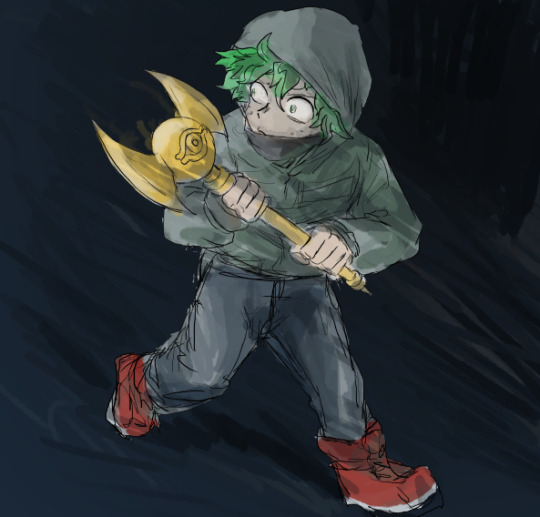
And this is the fic I wrote on top of it! Enjoy!
2 notes
·
View notes
Photo

doodles
#erehisu#erekuri#eren x historia#fanart#my art#blackrazorbill#I didn't learn from refs so theyr prob off#but whatever
224 notes
·
View notes
Photo


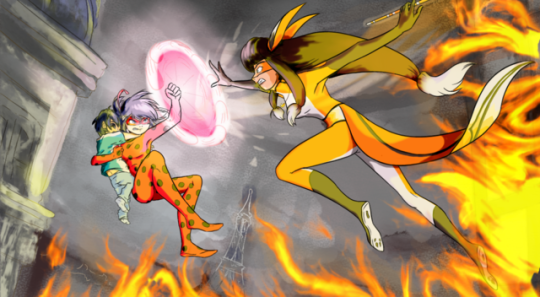

What is this nonsense, and why did I draw it? Ah. Well. Apologies for the bad handwritten text. I guess this is an opportune time for comic book homage, that I’m too lazy to polish now. Enjoy!
#miraculous ladybug#miraculous: the tales of ladybug and cat noir#Marinette Dupain-Cheng#lila rossi#volpina#mockup cover#fanart#mine#blackrazorbill#made a quick edit on the text because this was posted at one AM
285 notes
·
View notes
Text
Soul Dichromatism: Love, Hope and Compassion (Part 3)
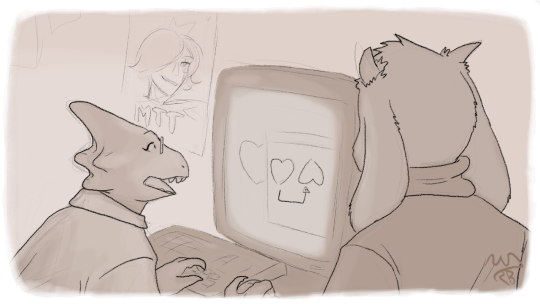
In BlackRazorBill's fanfiction Soul Dichromatism, monsters broke the barrier and are in a decades-long war with humanity. There seems to be no end in sight. But when an experimental device used on a human captive (Frisk) unexpectedly turns the human into a monster, monsters believe “monsterification” is the way to end the war. This is due to monsters’ beliefs monster souls are made of hope, love and compassion. (the HLC belief for short) By turning humans into monsters, it is believed humans shall more hopeful, loving and compassionate. By turning humans “good”, the war will end.
But if monsters are so compassionate due to their souls being partly made of compassion, why do they still commit non-compassionate atrocities of war?
I speculate this is due to four reasons:
"Depersonizing" Propaganda
Personal Experience
Emotional Exhaustion/Maintenance of Morale
Out-Group Threat
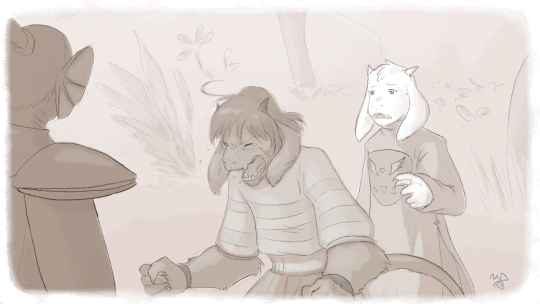
1. Depersonizing Propaganda
(I’m using “depersonizing” as a species-neutral alternative to “dehumanizing”, because it’s the humans being “dehumanized” by virtue of their being human, not monster.)
The first reason monsters don’t act compassionately is propaganda. The HLC belief, and other beliefs on monster and human souls works as depersonizing propaganda, even if it wasn’t originally conceived as such. The beliefs on human souls imply humans are inherently spiritually inferior to monsters, and are less loving, less compassionate, and more prone to “negative emotions” than monsters. With this in mind, killing humans isn’t as horrible as, say, killing a monster.
The HLC belief and other beliefs on human souls are so widespread and/or strongly held, they persist even in those sympathetic to humans. It is Alphys, a scientist who studies human souls and loves human anime, who claims human souls’ “stronger potentiality for negative emotion” as the basis of her suggestion Frisk’s hatred for monsters will subside once fully monsterified.
Even Asgore, who adopted a human child and surely interacted with humans prior to the first human-monster war, seems to believe humans aren’t as hopeful, loving and compassionate as monsters (though they can be, if helped):
(Chapter 3) Asgore: “Humans… are a troubled species, Asriel; as much as we became now… but they can be capable of love, hope and compassion as much as we are, if we give them the chance.” (This suggests Asgore thinks humans aren’t already as capable of those emotions as monsters)
(Chapter 26) Asgore: “…[Asriel], do not sell [Frisk’s] ability for compassion this short. Humans…may be more disconnected from those emotions [hope and compassion, possibly love] than us, however, with the help of loving friends, I do believe-”
As far as can be told so far, only Asriel denies the claim human souls do not need hope, love and compassion to exist:
(Chapter 32): “There were many monsters who thought that, because humans could live without Hope, Love and Compassion, that they didn’t need those things. [...]Asriel knew it was untrue from the time they knew Chara. [...]Asriel knew humans fell down too. They did not lie down and rest like monsters, humans still moved, talked and could even pretend nothing was wrong, but they were falling down all the same.[...]Humans needed Hope, Love and Compassion as well.”
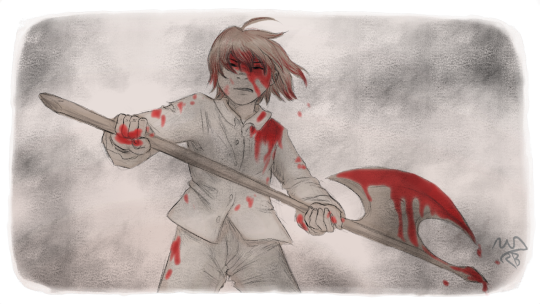
2. Personal Experience
The second reason monsters don’t act compassionate are the personal experiences of soldiers, and those affected by the war. A battlefield is no place to make friendships with the other side, but that’s Undyne’s only exposure to real humans. Though Undyne admires human-made anime and the ideals of anime, she is not compassionate towards humans because they murder soldiers she cares about.
(Chapter 26) Undyne: “[When Asgore was unable to] I ended up teaching most of [the new soldiers].” [...] “I think… I think the hardest is when those youngsters end up dying before I do. I got no kids yet, but… but I bet this is how parents feel when… when they lose their children.”
Artie (Monster Kid's name in the fiction) also has personal reasons to feel no compassion towards humans, even if humans' effect on him is indirect. Artie’s sister fell in love with a soldier. When that soldier was killed by humans, his sister fell into despair. Eventually, she became so hopeless she became “fallen down”, a coma-like state preceding death. (in the fiction, monsters can die from lack of hope) Artie seems to blame humans for his sister's death. This blame, a possible desire for revenge, and perhaps glamorous TV ads of war1 motivates him to become a soldier.
It’s unclear whether Sans believes the beliefs on human souls. He might have personal reasons to believe humans are cruel, due to Frisk trying to kill his merciful, friendly brother Papyrus. He calls Frisk “an enemy” on multiple occasions, and his “skeletons in the closet” story in Chapter 16 might suggest he thinks humans are violent and untrustworthy.
However, Sans says he doesn’t think he hates Frisk. He wishes he could, but Frisk is not easy to hate. It’s possible his distrust of humans comes not from propaganda, but from realizing the two groups are on opposite sides of a conflict with two different end goals. He might not have a strong animus against humans in general, just Frisk in specific.
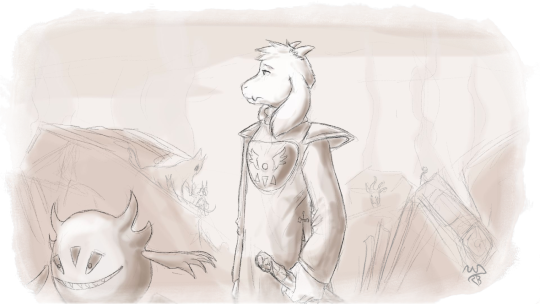
3. Emotional Exhaustion/Maintenance of Morale
The third reason monsters aren’t compassionate to humans is emotional exhaustion/maintenance of morale. Some monsters, such as Asriel and Asgore, have positive associations with humans but still do not act compassionate to them. This is because the circumstances of war mean there is presently no feasible way to be compassionate2; Humans are simply too dangerous as individuals and as a society.
Extending compassion to the enemy, but being unable to stop the war, might cause a sense of internal turmoil and helplessness. Beyond the direct threat of humans, this gives the war an extra layer of danger: in this fiction, HP is an acronym of “HoPe”, so when monsters are totally hopeless, they fall down and die.
Hardening their hearts and cutting out all compassion for the enemy, (if it’s even possible for them) would help them cope with a war with no end in sight. It’s possible this hardening of the heart is an effect of gaining LV.
One can see coping mechanisms in Asriel and Undyne. Despite his positive experiences with humans, Asriel feels nothing when he kills them,3 and if what Frisk thinks is true, Undyne’s face becomes emotionless in a “mask of war” and she dissociates4 to cope with the horrors of combat.
(Chapter 30) Torria: “The people at large must have hope, and it is up to us [the rulers] to give it to them…”
Due to monsters’ need for morale/HoPe, at many points in the fiction various monsters reduce the human-monster Frisk to nothing more than a symbol: a symbol of hope for a peaceful future where monsters don’t have to kill. In doing so, they have no empathy/compassion for Frisk. When it comes to humans more generally, Torria (a relative of Asriel on the Boss Monster council) suggests using monsterification on children to raise monsters’ hope, as well as population.
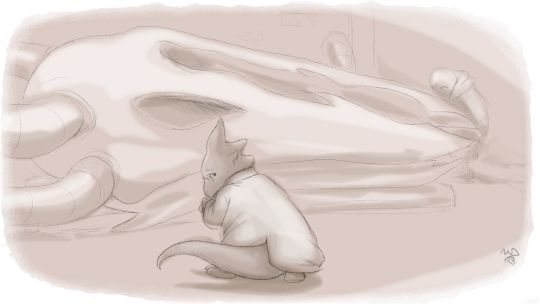
4. Out-Group Threat
(Alphys in front of a prototype for a magic cannon that can blast across continents)
The fourth reason is that monsters believe humans are a threat to their existence. Humans are very dangerous both as individuals and as a whole, due to their physical strength, “killing intent” bonus, sheer numbers relative to monsters, and, to a lesser extent, military technology. Indeed, they’re so dangerous it’s too much of a risk to make them prisoners of war, so every battle is “take no prisoners” by default.
While many of their tactics failed against monsters, humanity still seems to have a massive military, to the point of still causing trouble at the western coastal front of the war. Though humans tried diplomacy in the past, it failed, for monsters were too “drunk on recent victories”. Now, monsters have killed so many humans that monsters believe diplomacy is no longer an option. As monsters believe the humans would annihilate them if given the chance, monsters feel the only way to ensure their own survival5 is to destroy humanity, either completely or almost so.
Even if monsters are indeed more compassionate than humans, it certainly doesn’t show up when fighting humans. They seem subject to the same psychological tendencies as humans, for greed, rage, and a desire for revenge were factors in both starting the war and continuing it.
Reducing or eliminating the threatening nature of a situation reduces out-group hostility.6 It is possible that, if humanity had a ceasefire and stopped attacking monsters/trying to regain territory, aggressive or non-compassionate sentiment towards humans would subside. However, it is unlikely at this point. Just as in the first Human-Monster War, the fear of a being with godlike power (here, Asgore) is likely to interfere with anything approaching diplomacy. (especially since diplomacy was refused before)
At this point, monsters believe there’s no backing out of the war. As Flowey might say, “In this world, it’s kill or be killed!”
“Nice TV images”, Chapter 9 ↩︎
Not for lack of trying: “They [monsters] tried to keep human prisoners before, they were still trying occasionally, but it turned out to be too risky [because they kept trying to flee and harm monsters]” -Chapter 1 ↩︎
Chapter 21, Asriel: “…I think… I think the actual hardest time…[killing a human]” He snorted and looked at her with an expression of tired sadness. “…It was when I realized I felt nothing at all anymore.”
↩︎
Chapter 12: Undyne had her face completely devoid of any emotion.
A mask of war… something Frisk had seen on human soldiers.
‘Dissociation’, her dad had told her… Get away from the pain… get away from the horror… Become [a] spectator of your own body."
↩︎
Chapter 25, Undyne (to Frisk): “I think you’re WRONG about most monsters deserving punishment for what we do to your people, I DO believe we’re justified still, both to fight for our survival, AND to get revenge on what your people did to us in the first war.” (Emphasis mine)
↩︎
The Oxford Handbook of Diversity and Work, page 102. ↩︎
15 notes
·
View notes
Text
blackrazorbill replied to your post:
I love the robbery scene! But I figured they'd have kept the cube from the moment they meet Elfangor this time 'round XD
Actually, I’m not sure that would be possible given the constraints of canon. #20 strongly implies that the morphing cube quite simply couldn’t have survived how the destruction of Elfangor’s ship, and that it had to be the Ellimist pulling some nonsense that got the cube to David. So while it did occur to me while writing this, I’m 99% sure that such a thing wouldn’t be possible within the rules of canon. Because the Ellimist does dearly love fucking with Elfangor and his kin.
11 notes
·
View notes
Photo

blackrazorbill submitted:
Hi The Effing Tired, I’m dad.
#caretaker au#mod pics#lowercase love#art#submission#blackrazorbill#THIS IS TOO TRUE#we went through hell and high water to get today's post up#BUT WE DID IT#this is amazing bill i love it#left to right: ellipsis - eruto - minty
390 notes
·
View notes
Photo
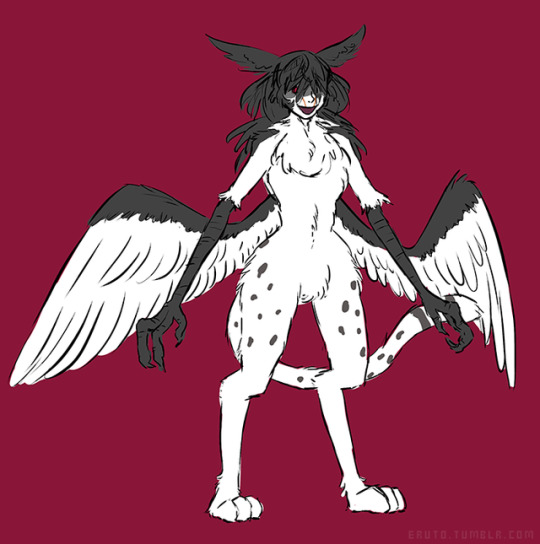
The very first drawing of a monster lady based off of @blackrazorbill‘s gryphon. Really love this one.
► [commission] ● [patreon] ● [kofi]
#eruto art#monster girl#griffin#blackrazorbill#baa#original character#since she was designed around an actual monster#she ended up with a really solid design
58 notes
·
View notes
Photo



second batch of colored dracs
117 notes
·
View notes
Link
And so begins the a fusion of two AUs: SIGILTALE and Soul Dichromatism.
SIGILTALE is by @kinaru-sheinto, or myself.
Soul Dichromatism is by @blackrazorbill.
#Sigiltale: Soul Singularity#Sigiltale#Soul Dichromatism#kinaru-sheinto#blackrazorbill#Chapter One: Singularity#my story
11 notes
·
View notes
Text
Hey guys! Just thought I would let yall know that I’ve updated my story! Here is the link below:
https://archiveofourown.org/works/15699882/chapters/43381901
Artwork done by: @blackrazorbill

Sneak Peak:
Plagg did his version of pacing, flying back and forth in front of the window whilst eating camembert. Adrien was in the restroom, taking a shower after his fencing lesson today. It was a one-on-one with that Kagami girl. He needed to speak to Fu, and after his talk with Tikki, wanted to take things into his own paws. Chomping down the rest of the cheese, he began tapping his chin, attempting to think of an excuse. Well, Master Fu did come in once saying he was his substitute Chinese teacher. They can just tell them that Adrien had to meet up with him this time or something. Yeah. That could work. Pausing in his floating, Plagg hovered as he looked out the window, thinking about poor Nuuroo. He didn't deserve this. Didn't deserve Hawk Moth. He hoped that having a talk with the guardian could help figure something out. Let the kids have a break, too, with that trip coming up. That would just result in all of them having a break. And since the kids know now, he and Tikki could have some time together. That’d be nice. He hadn’t seen his girl in a while. Being the two main kwamis in which everything was rooted in, they had a bond that was very unlike any of the others. She was, dare he say, his other half. He wasn’t the one to get cheesy, even though it was his one-true love. But he also couldn’t deny the truth. His cat ears heard the water shut off, alerting him that Adrien had completed his shower and would be walking out in a little bit.
#ao3#miraculous ladybug#original story#my story#when the heart cant stop fate#adrinette#Jagged Stone#Penny#Fang#Fang is cute#Plagg#Plagg is wonderful#Next chapter#Chapter Ten#Ahhh#blackrazorbill artwork
12 notes
·
View notes
Photo

quick doodle of @blackrazorbill‘s monster frisk from soul dichromatism! one of my favourite monster frisk designs.
#undertale#nochocolate drawings#frisk#monster!frisk#blackrazorbill#soul dichromatism#undertale spoilers#that's me. nochoco.#blackrazorbill is always drawing amazing fanart for other fanworks#soul dichromatism is definitely worth checking out as well
205 notes
·
View notes
Text
Undertale: What works and what doesn’t
Watching a disheartened Let’s Player playing Undertale made me ponder about attitudes I don’t really like about some fans. Namely, that many felt compelled to just outright spoil or bash Let’s Players who weren’t “playing the game the right way”.
Now, people throwing spoilers at new players is nothing new in any fandom, really. There will always be “those people” who will either judge you for playing badly, or “backseating” like crazy even when it’s not asked. But my personal impression is that Undertale brings out a very specific kind of excited fans who will feel stressed out when they see the game not being played “the correct way”.
The game has a multiple paths systems, and without even taking this into consideration, there should be no “incorrect” way to play a game. They are interactive medias; the player should make the experience. A case can be made for a Let’s Player to “play incorrectly” if they deliberately do not seek to progress in a game, but that isn’t what all those Undertale new Let’s Players were doing.
By all accounts, those people yelling at the new Let’s Players are wrong. But I had to wonder: what made the Undertale fans doing this compelled to act this way? What make those people believe that there is a correct way to play? And are they right?
I had to wonder: is that an attitude which originated from an inherent fault within the game itself?
(Disclaimer: This is but an opinion piece, which by no mean changes the fact that I believe Undertale to be a great game. I do think, however, that it’s a show of appreciation to be critical of something you love, and recognize its issues while still loving it. Spoilers are of course expected. And with that, let’s get on with it.)
After two years, I can say:
What I think works in Undertale:
A simple, but effective story, with a good narrative execution (At least, for the neutral/pacifist run)
A colorful cast of characters with endearing traits and compelling backstories.
A good natured sense of humor, which can tiptoe into meta*(1) without ever truly crossing it.
The combat system tries something unique, and if you like Earthbound type of witty combat dialogue, it can be pretty entertaining. The ‘defensive phase’ in bullet hell fashion is also a good experience in countering the usual RNG*(2) types of attacks you encounter in RPG. You’re not powerless against the monsters’ offenses, and trying to do a ‘no hit run’ is completely possible.
What I think doesn’t work as well:
Crossing through the underground can be long and boring if you’re not on your first run.
Combats can get repetitive, even with the SPARE type of dialogue mechanism. It’s something that can arguably go with the genre of the game, which is turn-based RPG inspired, and the encounter rate is fairly low overall, so I’m personally more lenient. It can be a deterrent for some, however.
The game may be ‘too easy’. I know the people who never played bullet hell type of game may not think so, and I know that people who play through the first time can have a hard time; but overall, unless you go ‘genocide’, the learning curve is fairly low, and it will only get easier with every new runs you do (I guess this is when we scream for a ‘hard mode’).
The multiple endings system is severely limited by something critical, and that is that the game itself does not value the multiple endings system, in spite of including this mechanism within the game’s story.
I believe this is the very last point which made the people commenting so insistent on making LPers play ‘the right way’, and I believe this may be the weakest point of the game. Both as a game and as a narrative experience.
The multiple endings system is undervalued, because only one ending matters
There may be many different runs you can experiment with, but the neutral ‘endings’ are basically the same thing: Sans calls you and you get a rundown on what happened after you/Frisk left the underground, which is fine, but doesn’t exactly inspire much. It may be a reason why, in spite of branching to interesting timelines, those neutral runs are much more rarely explored in the fandom.
The True Pacifist run is very clearly the ‘favored’ run. While playing through a neutral run is necessary to get it, you can pretty much finish a neutral pacifist run, then reload your SAVE to a point prior and finish the pacifist branch without issues. And while this is convenient, this is a deterrent from experimenting with the other routes. Flowey himself does a whole speech to emotionally compel you NOT to experiment. And while this is a good character piece that shows his growth? It also very much demonstrates that the game has a clear judgment on the players who DO try out other routes.
Now, maybe this is not the creator’s intent. I can’t possibly know. But what I see is that players are edged from the beginning to follow a clear line, and that is: the pacifist route. Flowey himself hints at it at the end of your first neutral run if you missed the memo before, that the game really wants you to go pacifist.
And while this is overall understandable for the characters to push you this way, the truth, is, however, that players are used to be led by such clues, and that most of everyone will follow the directions. This is how most of us learned to play our games. Thus, only dedicated players will start a game again after pacifist.
Compare and contrast with other multiple endings games. I can think of two types: one is a SMT or Mass Effect sort of choice, where the ending you chose is about your personal values, instead of an ‘objectively good’ ending for mostly everyone like what the True Pacifist ending in Undertale is.
The second type is something I’ve seen in visual novel types of games, like 9 Hours 9 persons 9 doors, where not only there are multiple endings, but the endings are required to obtain in order to unlock the ‘true ending’. It works similarly to Undertale in this way, except all the endings are shown as important for the game’s progression.
We don’t see that in Undertale. You can ‘finish’ the game with having done a single neutral and a single pacifist (and yeah, I’d use the term ‘finish’ for the True Pacifist route. It’s the only route with full credits). There is no reward for going through a neutral route apart from going through the neutral route itself. There is no incentive for a player to go through those, and worse, you’re ‘punished’ for ‘choosing’ a non pacifist neutral routes compared to the pacifist one, because you HAVE to start over to reach the ‘good end’ after you ‘mess up’.
This is never explicitly said, but it’s something the people who watch and criticize LPers who picks ‘bad options’ knows, which is a further reason for them to get upset about it, even if this is counter-intuitive to blame others like that, and far from the LPer’s fault. The truth is the game, in spite of having a multiple ending system, doesn’t particularly care for it.
And that’s the best case. The worst case is the genocide run, where the "you’re a figurative monster for doing this" message is pretty clear.
And… I believe the genocide ending’s message in particular works in detriment to the game’s scenario.
The genocide run ending is a narrative mess, because the game is too busy judging the player’s actions
Now, the truth is, Undertale’s story is excellent for being such a simple premise. It’s well-presented and executed. However, this, I personally believe, is only the case for the neutral/pacifist runs. To me, it’s clear that Toby Fox was mainly interested by this part. The royal family’s story IS the most compelling and deepest part of the lore, and there are good reasons to get invested in it. It also unfortunately helps in contrasting how confusing and badly executed the genocide run ending is.
Not everything is uninteresting in the genocide run. In fact, it can pack up a good emotional punch if you’ve already done a pacifist run and become invested in the characters (which, as I mentioned before, is the most common route). The characters themselves are showing greatly compelling new facets of themselves when faced with the menace that you/Frisk have become. It gives a nice change of path to the repetitive nature of the neutral runs.
But of course, the game is ‘punishing’ you, the player, for daring to do something so vile as to kill everyone. In order to unlock the genocide route, you had to go out of your way to kill every monsters in each area, which means going through the boring battle system ordeal many many times. The game does not want you to have fun in this route (Ironically, the two biggest fights of that routes can be a reason to do the route, if only for their challenging aspect).
The issue I have with this route, especially its ending, is that the excellent narration appears to have been forsaken and replaced by an ‘eff you for playing’ message. And that message takes the form of Chara.
Now, Chara is actually of fairly low importance to the game story itself, in spite of being present in all routes, on your character’s name screen, and as an ‘adequate red herring’ of sort, even if it’s solely from the player’s perspective. You’re encouraged to believe the ‘fallen human’ you named is the human you control, Frisk, when it actually is what the genocide run hints to be the lingering spirit of the first dead human, Chara, who latched onto Frisk’s soul when they landed on their grave at the beginning of the game. That’s a decent twist for the player, and gives an excuse for Flowey’s obsession with Frisk, but the story can actually be told without Chara’s spirit to ever be relevant if you skip the genocide run, like most people did.
And within the genocide run itself? This is where Chara’s characterization gets messy.
I’m not going into any theories about them; whether they were ‘bad from the start’, misunderstood’, a ‘massive manipulator’ or ‘the actual narrator of the game’ changes nothing in what I will say: The speech Chara gives at the end makes very little sense in the narration. That speech is put in a way which is toeing with ‘meta’ without ever making the line clear, like the game often does with its humor. In here, not only does it make what the ending is about very confusing, but it’s like trying to do a ‘take that’ at the player, without fully committing to it.
And no, I don’t believe this is a good characterization moment for Chara if you remove ‘the player factor’, simply because the speech makes little sense when addressed to Frisk, as it should be if you ignore the meta-toeing. Because Frisk SHOULD KNOW about Chara, since at least Home. Chara literally says ‘it’s me, Chara’ in front of the mirror. Frisk, as THE CHARACTER, not the player, should have either been contacted or tried to contact Chara much earlier and should be aware of Chara’s presence already.
This was, I believe, mostly done for a twist factor for the player, rather than a logical narrative choice. It may explain why so many AUs and fanfictions go with the ‘Chara possesses Frisk throughout the genocide route’ path, even if it’s something that is neither supported by gameplay, nor by the narration (people who mentions the occasional times when your character moves on your own shouldn’t ignore that this happens in pacifist runs as well, and is not a mark of genocide run specifically. And either way, at no point until the endgame are you prevented from RESETTING, loading, or even lose control in battle). In truth, Frisk being possessed is contradictory to Chara’s speech as well, but it’s a way people reconcile with the utter lack of characterization/actions of Frisk.
Was Frisk treated as a character, instead of a prop for the player to get judged by the game, I personally believe the Genocide run’s story would be logically more sound. Chara is as much of a prop in this. As stated previously, their impact on the other runs is minor/non existent. Here, they do not exist primarily as a character, but as a judge for your (the player’s) actions. And while they’re supposed to be a judge for Frisk? Story-wise, the speech is nonsensical at that specific moment, and as it is formulated.
Were it a proper story, Chara would have ‘greeted’ Frisk much earlier. But this would of course mean removing the player/Frisk’s confusion the game wants to keep so much. Frisk would have needed to be shown as their own character prior to the True Pacifist run. This is where it fails to me; when it substitutes a chance at story-telling for a ‘look at what you’ve done’ speech.
Most likely, this was a deliberate choice on Toby’s part. The gameplay is overall a downgrade in fun because the player ‘tried to be smart and go against the morally right’s obvious choice’. It makes some sense for the story to break apart in this run as well, for ‘no fun is allowed’ here. It’s not a choice I approve of personally, but it’s a choice.
But the entire scenario falls apart at that point as well. Chara “erases” the world you play in through no means that are explained in game. There are no logical reasons presented within the game as to how or why they have that power. Sans hints at the timeline being in danger of being erased, but that in no way constitutes an explanation for what happens.
The True Pacifist Run story is decently established, while the other runs’s endings have plot-holes with no in-game explainations
Compare and contrast the Genocide Run with the Pacifist Run and the Neutral Run. In the pacifist run, Flowey’s ability to absorb both humans and monsters’ souls at the end? It was straight out set up and explained in the True Lab’s logs. It was explained that he was a vessel created for the purpose of hosting both kinds of souls, something monsters and humans are established to be unable to do. The way monster and human’s souls works is something the game took a long time to set up, just as it set up Asgore as a conflicted ruler with a lot of depth.
The neutral run, in comparison, has more explained, but also more things left in the air. Flowey’s battle has him use ‘savestates’. Which is both a meta reference and something that had been established very early on in the game. If you RESET/load in the ruins at the point Toriel asks you about your food preferences, she will mentions having feelings of already knowing the other humans she met before she met them, which strongly hints that other humans within this universe have a SAVE as well. And this makes sense of the Omega Flowey’s fight mechanism of his six ‘savestates’.
Things become less comprehensible at the neutral run ending, when Sans phones Frisk to fill you in on the underground’s situation. At that point, Frisk’s whereabouts are unknown, but they have definitely not been spotted in the underground. This is strange, because from what the game told us, Frisk should not have been able to escape the underground. They failed in absorbing a Boss Monster soul, which is what they would need to pass through the barrier.
Now, there are many theories for this (Frisk died, the barrier wasn’t that strong, the last battle pushed them out, etc.) I have my theories as well, and I’ve read many good pieces about them. I have read good pieces explaining the genocide run ending as well… but in the end? Those are just that. Theories. Within the game, you will not find a definitive answer for either how Chara ‘erased’ the world, or what happen to Frisk after the neutral run.
And my personal belief for why that is? I don’t think the creator was interested in those timelines as much as he was in the True Pacifist run, which is the most complete and explainable timeline. That’s the most complete story. That’s the one that matters.
In the other runs, the narration is taken over by the game’s need to comunicate to the player
The actual non-narrative answer for why Sans phones Frisk at the neutral end, and the universe hasn’t RESET yet, in spite of Frisk’s potential demise? The player had to be informed of what their impact on the world was. It wasn’t thought of as a much as a speech to Frisk, as it was to the player. For all the game tries to make Frisk their own character at the end of the True Pacifist, Frisk is treated as a prop for the player throughout the game.
The actual non-narrative answer for how and why Chara erased the world in the genocidal run? The game ‘needed’ to punish you for what you’ve done. This is the very reason why your True Pacifist ending gets ‘tainted’ by the creepy pasta vibes. And this is why there are no narrative impact within the true pacifist run itself when it becomes a ‘souless pacifist run’ after a genocide.
The story potential is treated as unimportant compared to teaching you, the player, how ‘actions have consequences’ (regardless if the way you play a game has any impact on whether you’re a good person or not. I doubt most of the people who killed monsters in games are devious killers IRL). I’m personally not fond of this ‘judging’ attitude the game has over you when playing it. Especially when it’s done in detriment to potentially thrilling storylines. But that’s a creator’s choice, and I respect that.
How the game’s weakness may have turned in its popularity’s favor
If anything, an argument could be made that those ‘unfinished’ worlds that are the genocide and the neutral runs have done great in inspiring fan authors to explore them, and make sense of them in the way the game hasn’t. Just as Flowey’s ultimate fate in the True Pacifist run have inspired people to do their own takes at ‘saving’ him. And just as ‘the Gaster mystery’ inspired, even if it’s just a bunch of creepy stuffs thrown in at the end of the game programing (from the game code itself).
There are plenty of good stories that haven’t inspired as many works as Undertale, and this is because, I believe, if a world feels ‘complete’, we’re less inclined to work with it. Undertale’s world doesn’t feel ‘complete’ (in my opinion, because the creator himself did not think everything through, or cared enough for those elements). This makes it ripe for imagination.
My conclusion
The most surprising thing about the alternate runs is that Toby has even programmed them at all, given the clear bias for the pacifist ending. But I guess the choice ‘had’ to be presented, even a choice that is disapproved of.
I don’t believe this was a necessary choice, though. From the genocide run’s rushed and muddy story, I think it’s clear Toby was mostly interested in the True Pacifist Run. Would the game have suffered from removing the ‘choice’ of the equation? And just sticking Frisk as a pacifist kid freeing a race of warmongering monsters through the power of lowercase love? Maybe. Maybe not. As it is, I personally think that the game is not really the multiple endings choice it’s presented as. And I don’t believe it wants to be, for better or worse.
----
*(1)Meta: (from https://en.oxforddictionaries.com/definition/meta) “(of a creative work) referring to itself or to the conventions of its genre; self-referential”. In this case, it would mean the game makes reference within its universe that it is a game. Self-referential games exists, but Undertale actually never makes the step to crosses into meta references fully.
*(2)RNG: (https://en.wikipedia.org/wiki/Random_number_generation) is a gamer term used to talk about Random Number Generation, which is when an element of ‘luck’ is introduced in the gameplay via a program that will generate a random result. An example is how in Pokémon, an attack can occasionally miss, or cause additional effect such as ‘poison’ or ‘burn’ regardless of the player’s input. This is a widespread mechanism in old style RPGs, but Undertale circumvents this by giving the player an action phase to counter the enemy’s attack instead.
#UT#Undertale#genocide run#pacifist run#Chara#Frisk#the player#toby fox#rant#blackrazorbill rant#long winded rant#this is just my personal opinion#theories and headcanons are great though#except when they start warring on each others because it's dumb#I think sometimes we just gotta admit that a story just isn't perfect and cannot be fully justifiable by itself#it's ok
67 notes
·
View notes
Photo
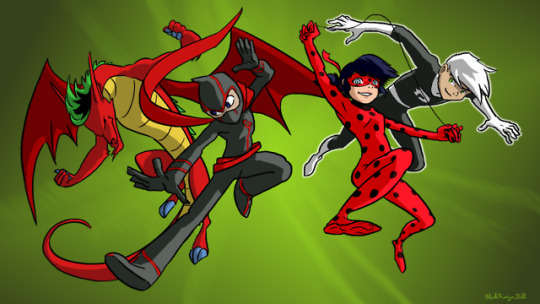
Secret Quartet: American Dragon: Jake Long; Randy Cunningham, 9th Grade Ninja; Miraculous Ladybug; and Danny Phantom.
#secret quartet#Miraculous Ladybug#Danny Phantom#Randy Cunningham: 9th Grade Ninja#American Dragon: Jake Long#Marinette Dupain-Cheng#Danny Fenton#Randy Cunningham#Jake Long#my art#Blackrazorbill#yes that's me#secret trio#plus one#Marinette is head strategist in this group I headcanon#teen superhero leads teaming up together#mine
708 notes
·
View notes
Text
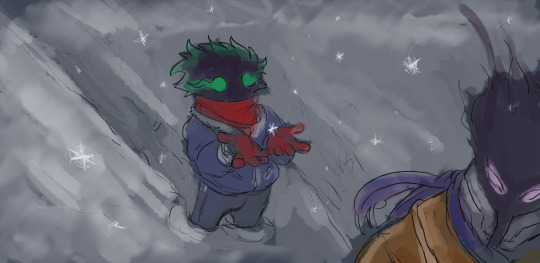
Look at this awesome pic @blackrazorbill did for the Winter Exchange ahhhhhh! So precious 😭❤️. I love you Bill.
774 notes
·
View notes
Text
Soul Dichromatism: Love, Hope and Compassion (Part 1)
Introduction
1. LHC Belief
2.Evidence For the LHC Belief
3.Evidence Against the LHC Belief
0. Introduction

In the fanfiction Soul Dichromatism, there is one major canon divergence: it wasn’t Asriel who absorbed the Fallen Human's1 soul, but Toriel. Toriel, seeking more human souls through peaceful means, roamed through graveyards looking for the souls of recently deceased humans. She collected four souls until humans killed her. As in Undertale, in his grief Asgore declared war on humanity. He absorbed Toriel’s collected souls, passed through the Barrier, and slaughtered the nearby human village, obtaining three more souls. He then broke the Barrier, freeing monsterkind, and promised his people all the lands of the “overground” (that is, the world outside the Underground).
The story takes place decades after this. In this fiction, Frisk (who is female in this depiction) lives in a human settlement on the border of monster-controlled territory. An experimental Determination-draining device (the Soul Drainer) is clamped onto her soul, unexpectedly causing her to change into a monster.2
Many characters believe that, once the transformation process is complete, Frisk will change to be more loving, compassionate, and hopeful than she was as a human, as monster souls are supposedly made of love, hope and compassion. The belief that monster souls are made of love, hope, and compassion (the "LHC belief", for ease of reference) is a major part of the plot.
But what if it’s not true?
1. LHC Belief

(Thanks to Nochocolate)
Within the game, there is not actually evidence for monster souls being made of hope, love and compassion. Though “people say monster SOULs are made of [love, hope and compassion]”, that doesn’t mean it’s true. After all, people say (or rather, a nursery rhyme claims) that little girls are made of “sugar, spice, and everything nice”, but this is demonstrably not true. As the game says, “the absolute nature of “SOUL” is unknown”.
2. Evidence For the LHC Belief
Upon learning about the LHC Belief, Frisk considers it pro-monster propaganda. However, the belief does have some support: in Soul Dichromatism, monsters indeed need hope to live. Without hope, they enter the “fallen down” state, a coma-like state which precedes death. In fact, within the fiction HP (like LV) is an acronym standing for “HoPe”.3, 4
Though there’s no evidence love and compassion are similarly necessary for monsters, it’s likely many monsters extrapolate it is so because of hope’s effects.
The LHC belief is treated as truth, rather than folklore. Alphys (who, as a scientist, should be able to distinguish science from folklore) even mentions the LHC belief as a rationale for letting Frisk out of her cell in Chapter 5:
Alphys: “[Monsters have to rely on] Hope!” [...] “Love and Compassion as well, but most importantly ‘Hope’! Hope is what prevents us from falling down! …Humans have ‘Hope’ as well, but aren’t dependants [sic] on it; however…”
Asriel: “…However, If a human soul like Frisk’s loses access to both its main energy and Determination; it would need to rely on ‘Hope’,”
3. Evidence Against the LHC Belief
While in Soul Dichromatism hope is obvious for its role as a vital soul sustainer, there’s no comparable evidence for the role of love and compassion.
In Chapter 33, Frisk observes that monsters are more compassionate and loving than humans:
“Monsters were not a people that would let one of their own pass out from cold and hunger in the street. […] it was something they had over her people [humans]; even with the tight community she belonged to, strangers were more seen as potential threat than potential friends.”
However, in the same chapter Frisk notes:
“Monsters, with each other, could very much display the love, hope and compassion they claimed to have. With humans, this was another story altogether.”
Such selective compassion exists in real life, as compassion (or rather, empathy) is extended more readily to those of the same demographic as oneself. This is true for monsters in Soul Dichromatism.
Monsters, as a whole, aren’t loving nor compassionate towards humans. This is especially obvious with Sans, Undyne, Torria5, Artie (the name given for “Monster Kid”, who is a teen here) and Asriel.6 Were their souls actually made of love and compassion, surely repeatedly acting in ways contrary to those traits would be unhealthy. This is the case for hope: monsters “fall down” when they have no hope. Even if monsters overall have a greater tendency towards love and compassion than humans, the argument that their souls are made of love and compassion isn’t as watertight as the argument their souls are made of hope.
Frisk’s belief that monsters are more compassionate than humans is best explained by two things.
One: Frisk doesn’t know much about humans’ levels of compassion beyond her own culture.7 If Frisk knew of a human culture much more compassionate than her own, she might not make this sweeping conclusion about humanity.
Two: Monsters’ observed compassion comes from in-group prejudice, rather than the fact their souls are made of compassion. Prejudice is not merely disfavoring one group another, but also favoring one group over the other. (the effects of the two are often the same) That monsters act as if all the kingdom is one village may not come from their souls, but as an effect of culture of socialization.
Overall, the case against the truth of the LHC belief is much stronger than the case for it. However, it should be noted that absence of evidence isn’t evidence of absence. Perhaps compassion and love are indeed vital soul sustainers, but the narrative hasn’t provided any examples.
If the LHC isn't true, then why does it exist? Why did it persist to the modern day? The answers will be in part 2 of this series.
The Fallen Human is explicitly called "Chara" here, their default name in the game. ↩︎
Slight spoiler: Technically, she wasn't changed into a monster, but her body and soul traits were substantially changed so as to resemble a monster's. ↩︎
By this logic, it’s suggested Sans’ HP is 1 because he’s a nearly hopeless individual. ↩︎
The idea that HP stands for Hope is common speculation among Undertale fans, but to discuss it in detail here would take up too much space. ↩︎
A relative of Asriel’s, an "original character" that does not appear in the game. ↩︎
Asriel is a complex case. Though he's killed many humans, the guilt of it weighs especially heavily on him because his sibling and best friend, Chara, was a human: "Asriel may have been able to kill in cold blood, but that did not mean he took any pleasure in killing Chara’s and Frisk’s kind."-Chapter 22 ↩︎
Whatever that culture is: it's not described other than being on the border of monster-controlled territory. ↩︎
56 notes
·
View notes
Text
Drag on All for One
Drag on All for One
by BlackRazorBill
All for One thought nothing could surprise him anymore, but a Quirk misshape sent him to an unfamiliar place, and he is forced to realize that he has been very wrong.
As usual, it's All Might's fault, of course.
(or, the Au where instead of Izuku being the 'unwilling son', it's AFO being the 'unwilling dad')
Words: 11924, Chapters: 1/1, Language: English
Fandoms: 僕のヒーローアカデミア | Boku no Hero Academia | My Hero Academia
Rating: General Audiences
Warnings: No Archive Warnings Apply
Categories: Gen
Characters: Sensei | All For One, Midoriya Izuku, Midoriya Inko
Relationships: Midoriya Izuku & Sensei | All For One, Midoriya Inko & Sensei | All for One
Additional Tags: Spirited Away AU, Alternate Universe - Fantasy, Spirited Away fusion crossover, Sensei | All For One is Midoriya Hisashi, not that he knew about that part until recently, Dragon Midoriya Izuku, dragon midoriya inko, AU of an AU, Switch based on tuna's Spirited Away AU, dad for one, AFO x Karma, Animal Transformation, implied man-eating youkai, could also be called 'AFO's very bad day', Good Parent Midoriya Inko, All for One is as much of a bastard as he is in canon, Pre-Canon, pre-All Might's injuries, pre-Tenko getting renamed Tomura but AFTER he killed his family and was taken in by AFO, Crack, Crack Treated Seriously, But Still Crack
Read Here: https://archiveofourown.org/works/29297385
#AO3 Feed#FanFiction#AO3 Izuku#♦#Izuku Midoriya#AFO#Hisashi Midoriya#Inko Midoriya#R:G#A:Black#Dad for One#Dragon AU#Fantasy AU
123 notes
·
View notes